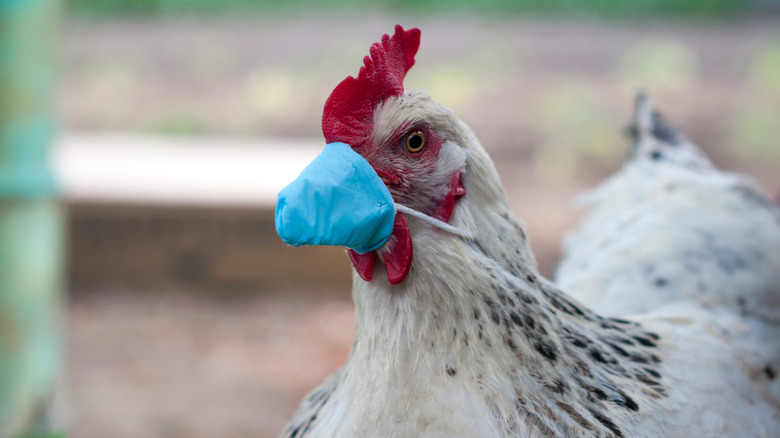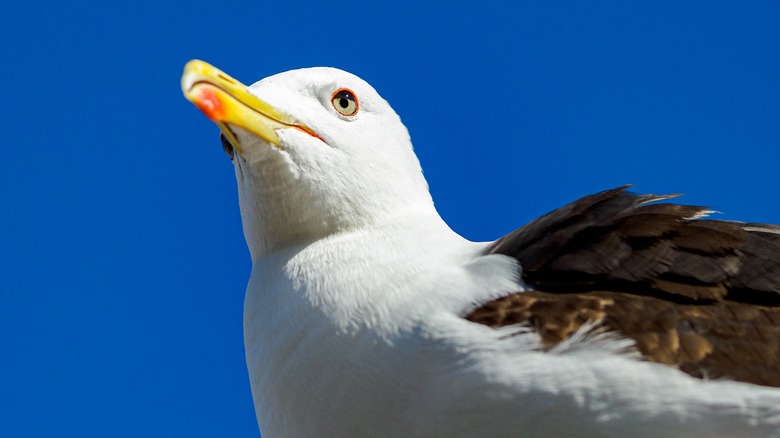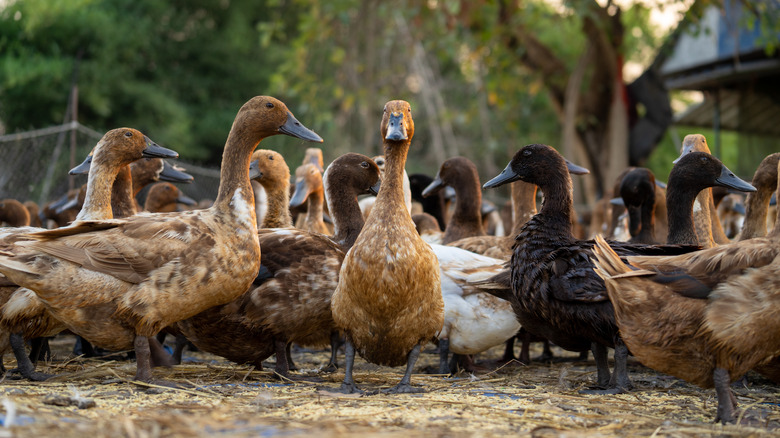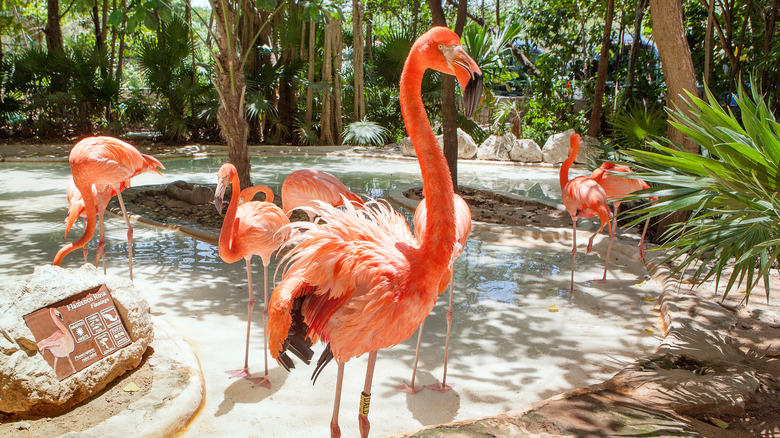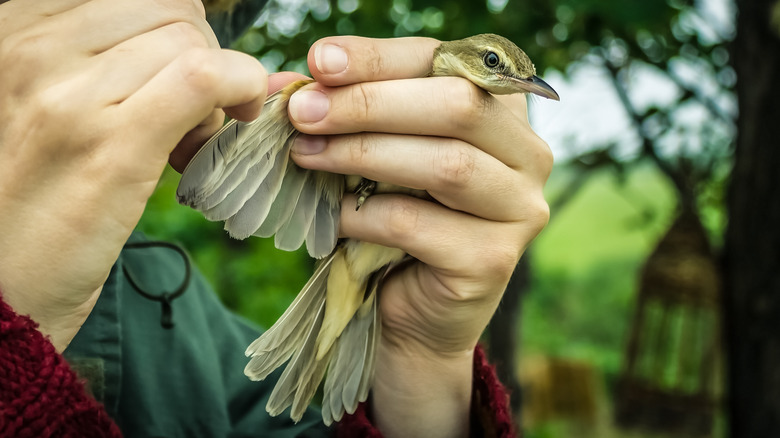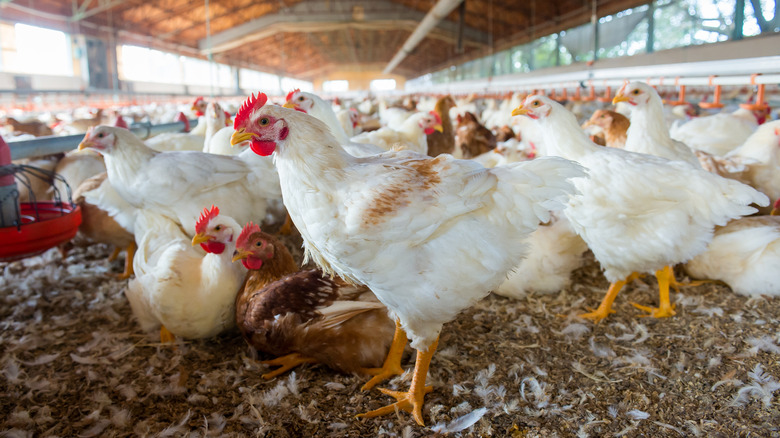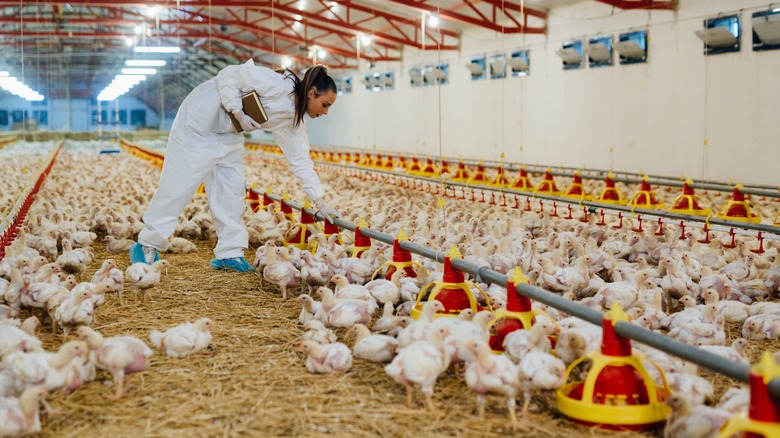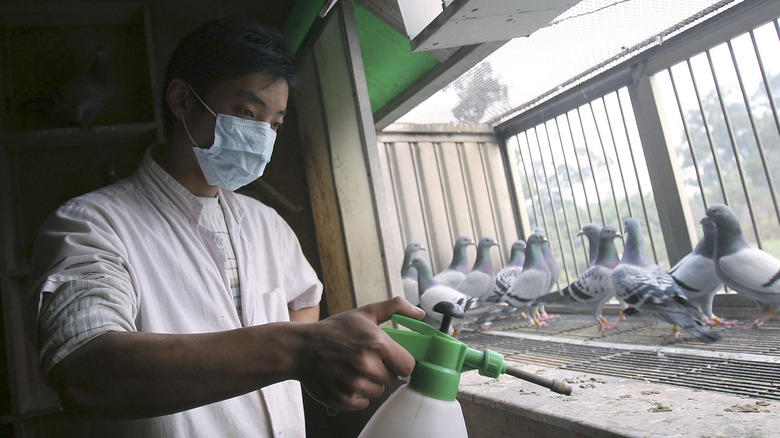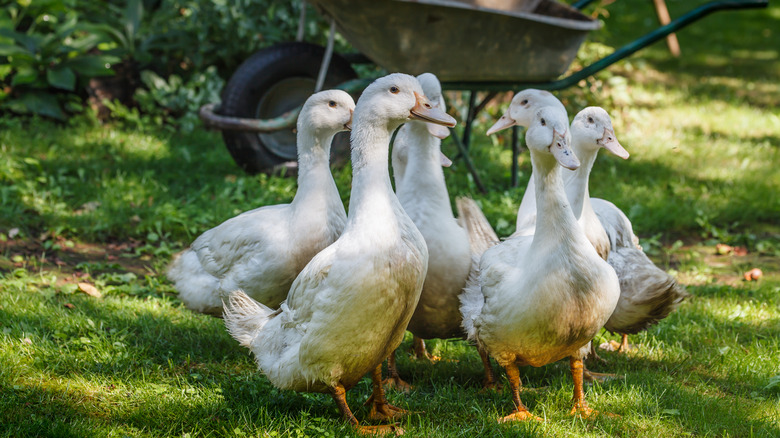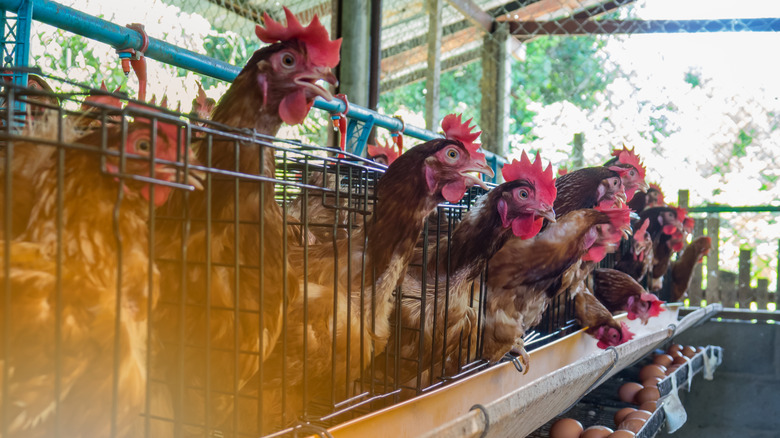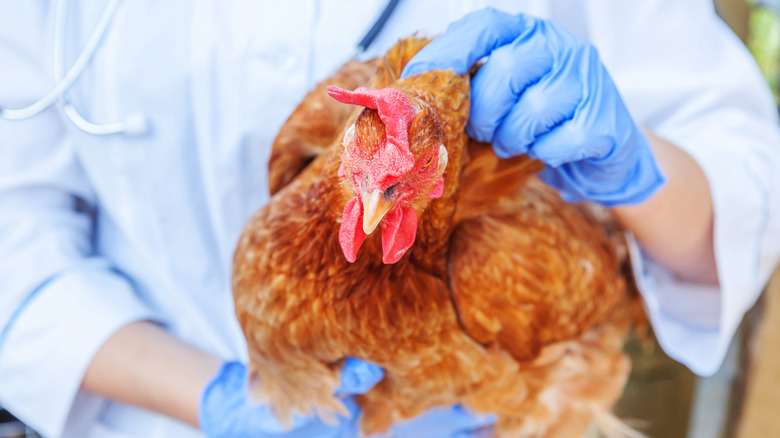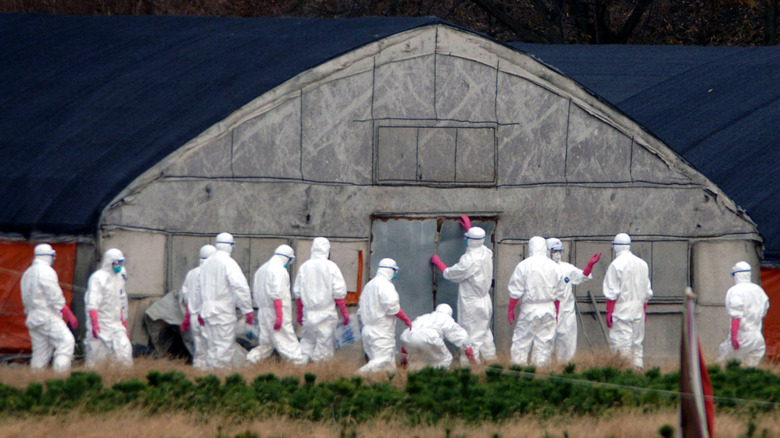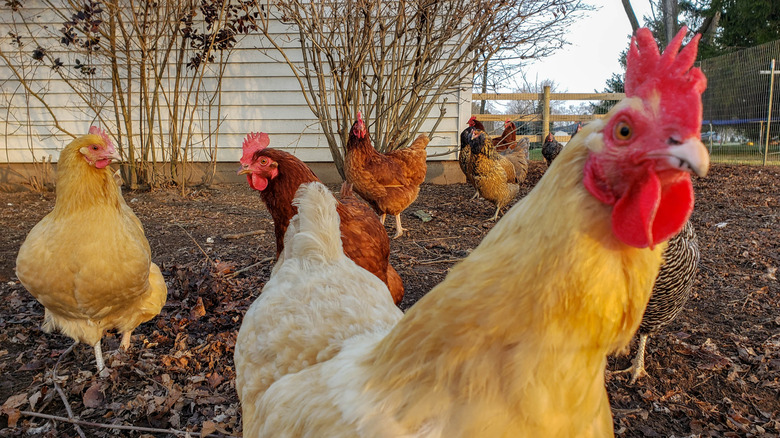Bird Flu Explained: Everything You Need To Know
It's the spring of 2022, and the masks are finally coming off. At last, there's a light at the end of the pandemic tunnel, and right there in that beam of sunshine you can see ... bird flu. That's right, everyone, a new virus has moved in to take the place of the old. Or more accurately, it's moved in alongside the old, because COVID's not going away anytime soon.
Now, if you were paying attention back in 2005, you probably know a little bit about bird flu, also known as "avian influenza." It's the very scary virus that bounced around Asia for a year or two, infecting humans and birds alike, but fortunately failed to become the COVID-style pandemic scientists feared it would become. Now it's happening all over again — only this time, the virus is spreading farther and faster.
Thankfully, though, this virus is different from the one that terrified the world back in the mid-2000s. Here's what you need to know about the 2022 strain of avian influenza.
Avian flu is spreading from east to west
This particular strain of avian influenza was first detected in eastern Canada in late November of 2021 (via the Toronto Star). Patient Zero was a great black-backed gull that was found at a pond in the city of St. John's, Newfoundland and Labrador. Just one month later, the virus killed 360 birds at a petting farm on the Avalon Peninsula in Newfoundland.
By January, the virus was in the United States. According to the U.S. Department of Agriculture, the first known cases appeared in wild birds harvested by hunters in the Carolinas, but by early February, it had also been found in Virginia, Florida, and Maryland. In just the few months since, it's been relentlessly marching across America, infecting wild and domestic birds in 32 states (via the CDC). Avian flu can now be found as far west as Idaho. In the United States alone, there have been 283 outbreaks in 159 counties (as of May 5, 2022).
This virus is highly pathogenic
Like influenza strains that infect human beings, avian flu isn't just a single virus (via the Food and Agriculture Organization). There are multiple strains, and each is placed into one of two categories: highly pathogenic (HPAI) and low pathogenic (LPAI).
The H5N1 virus that's circulating in the United States right now is in the HPAI category. That sounds bad, but pathogenesis in this case is defined by how virulent the virus is in poultry, which doesn't necessarily mean it's also virulent in people. An HPAI virus can wipe out entire flocks, while an LPAI virus is one that could potentially infect poultry but doesn't really make them sick.
Avian influenza is spread via pretty much everything that comes out of a bird: saliva, secretions from the nose and eyes, and feces. The Food and Agriculture Organization (FAO) even warns against eating eggs with runny yolks, though they've kind of always warned against that. According to the Mayo Clinic, you could in theory contract bird flu from eating undercooked eggs, though it's unlikely that eggs from infected birds would ever make it into the food supply (via the USDA).
Avian flu is mostly spread by aquatic birds
Here's some good news: For the average city-dweller, bird flu is unlikely to ever pose a serious threat, as long as it doesn't mutate into a form that can easily spread from person to person.
According to the CDC, the primary vectors of this virus are aquatic birds, which includes species like ducks, geese, gulls, terns, and the like. Even if you spend a lot of time on the beach, you're unlikely to come close enough to one of these birds that it will be possible to contract avian flu from one, unless a gull happens to steal your french fries or poop on your head. (On second thought, maybe you should stay away from the beach.)
The CDC also notes that most birds that carry avian flu are asymptomatic, which means they can happily fly around from pond to pond spreading the virus, so it's a very good idea to avoid feeding ducks and other aquatic birds. Health authorities in some states have even asked people to stop putting out feeders for local songbirds (via the Michigan Department of Agriculture and Rural Development) in order to help prevent the spread of the virus.
Avian flu has been found in 51 different bird species
The potential for transmission to humans is scary, but avian influenza is exactly what its name implies: a virus that infects birds. Health officials are mostly concerned about the latest outbreak because of its potential to devastate the poultry industry and infect already declining populations of migratory birds.
According to the U.S. Geological Survey (USGS), avian influenza has been detected in 51 different American bird species so far. And it's not just ducks and gulls, either. Affected species range from raptors all the way down to songbirds, though to be fair, it's so far only been found in a couple of different kinds of songbirds. Some of the virus's known victims include at least 200 black vultures in a Florida state park and 48 bald eagles (via Science). The USGS also notes the deaths of peregrine falcons, great horned owls, and red-tailed hawks. Raptors often prey on waterfowl, which is probably how they contracted the virus.
Zoos are isolating their birds in an effort to protect them
Zoos have a lot of wildlife species that could be considered rare or exotic. Many zoos even have breeding programs for threatened and endangered species. Generally speaking, every animal housed in a zoo represents a significant investment in time and money, so zoos have a particular interest in making sure that their animals stay safe and healthy.
This HPAI outbreak has so far affected twice as many different bird species as the last one (via Science), which means no one can really be sure which species are the most vulnerable to infection and death. According to the Associated Press, zoos aren't taking any chances — they're bringing their birds indoors and isolating them from people and other birds. This means visitors aren't going to see as many feathered species as they would have a few years ago, but the alternative is much, much worse than a drop in visitation. An outbreak inside a zoo would almost certainly mean the zoo would have to cull every avian species on display, endangered or otherwise. That makes it a scary time to be a zookeeper.
There is a reassortant version that includes genes from North American bird flu
Some viruses, like measles, never really change. That's why you can get a measles vaccine in childhood and be protected for the rest of your life. Flu viruses, though, are different. They're constantly mutating, which is why scientists still haven't been able to come up with an all-in-one vaccine that can protect you from every strain.
Viruses can also reassort, which means they can obtain genes from other viruses and use them to become a brand new virus. It's possible, for example, that reassortment between a human virus and an avian virus might produce a virus that would be better at infecting humans (via Nature).
Avian flu reassortants have already been found here in the United States. According to the USDA, the EA/AM strain of H5N1 is a reassortant of a Eurasian strain and a North American strain. This means that at some point, both viruses probably infected a single host and then had a gene-swapping party (via Emerging Infectious Diseases). So far, reassortant avian flu viruses don't seem to be especially virulent, but the right gene combination could potentially create a new virus with pandemic potential.
It's mostly impacting domestic poultry
No one wants to see bald eagles or already declining migratory species dying from avian influenza, but deaths in wild birds have, at least so far, been fairly limited. Most of the known infections have occurred in domestic poultry, especially chickens and birds. This includes backyard flocks, not just major chicken producers.
According to the USDA, the first poultry farm outbreak of this particular bird pandemic happened at an Indiana turkey farm in February of 2022. Shortly afterwards, the virus was found in poultry farms in three states, including a backyard flock. Since then, avian influenza has gone on to infect chickens and turkeys all over the eastern to midwestern United States, and it's not just in commercial farms but in backyard chicken coops, too.
And when domestic poultry come down with the flu, it's not like you can just keep them comfortable and give them a bowl of chicken soup or something — even one case of avian influenza typically means the entire flock has to be destroyed. So far, 23 million chickens and turkeys have been destroyed in an effort to limit the spread of the virus (via AP News).
The virus is also impacting the food supply
Because what we all really needed right now was for prices to be higher, all of this is making prices higher. Consumers who were buying more chicken to make up for not being able to afford beef are now finding themselves equally unable to afford chicken.
According to NPR, in late March of 2022, the average U.S. price per pound for chicken breasts rocketed up to $3.63 a pound, or 62 cents more per pound than it had been just a week earlier. That price was already 59 cents per pound higher than it had been in March of 2021. If you've been thinking about going vegan, now might be the right time to do that.
The price of eggs is going way up, too. Per the Washington Post, consumers now pay an average of $2.95 per dozen, compared to $1 per dozen as recently as November of 2021.
Most people at risk are those who work with poultry
The big question is: just how big is the risk to people? Well, the good news is, not very. At least not so far.
According to the CDC, avian influenza poses a very low risk to human beings. Most avian influenza strains don't infect people at all, and the ones that do infect people do so only rarely. Notably, the strains that have been known to cause human disease are the Asian H7N9 and the Asian H5N1.
When bird flu does infect people, it's usually people who work in poultry farms or have close contact with infected birds, such as people involved in disease control and eradication, animal welfare workers, and wildlife biologists (via the CDC). In fact, the CDC says infection probably happens mostly after prolonged, unprotected exposure to infected birds or a contaminated environment, so the people most at risk are those who are inhaling or otherwise contacting a lot of virus. This means it's less likely to be a threat to the average backyard chicken owner, even if the virus does infect that person's flock.
The risk of getting it from another person is very low
It's not really super likely that you'll get bird flu from your pet chicken or the bluebird that visits your feeder every morning, but it's even less likely you'll get it from your crazy neighbor who keeps 150 chickens in her barn. Examples of human-to-human transmission of avian influenza are even less common than examples of bird-to-human transmission. The few times it has happened, it has not resulted in epidemic spread of the virus.
According to the CDC, in 2003, two poultry workers may have spread H7N7 to three family members. The operative word here is "may" — it really just means they had suspicious symptoms, not that the cases were confirmed. Similarly, in 2004, a sick child probably passed H5N1 along to her mother and aunt, and in 2007, a father may have contracted H5N1 from his son.
There have been a few similar cases over the years, but most involve very close contact between family members. In short, this means that even though the virus can potentially pass from person to person, it's just not that contagious in humans.
It's not the same as the 2005 strain
The thing that's really freaking everyone out right now is the fact that in the very recent past, avian flu has been known to be deadly in humans.
In Indonesia, for example, the 2005 strain of H5N1 had a case-fatality rate of 76% (via the Journal of Infectious Diseases). That means more than three-quarters of everyone who contracted avian flu during that outbreak died from the disease. Compare that to COVID-19, which has a global case fatality rate of 2 to 3 percent (via the British Medical Journal) and still managed to terrify the entire world, and ... well, it's not really something you'd want to spend too much time thinking about.
According to the CDC, though, this particular H5N1 is different. The currently circulating virus is the predominant subtype pretty much everywhere in the world, and it doesn't have the same changes that made earlier H5N1 viruses so deadly to people. The CDC also notes that it's hard to say just how this particular H5N1 strain will affect humans, because so far, there haven't been enough infections to provide a decent picture of what human disease might look like.
The first human case was in the UK
During this outbreak, there have, in fact, been only two confirmed cases in people (so far).
According to the World Health Organization, the first laboratory confirmed case was in the United Kingdom. The case involved a 79-year-old man who kept 20 ducks inside his house and had another 100 ducks living on his property (via the Guardian). The ducks developed symptoms of avian influenza on the 18th of December, 2021; less than a week later, nasal swabs confirmed that the ducks' owner had the disease, too.
This is only one case, so it's impossible to use it to draw any conclusions about how dangerous the virus is. Still, it's worth noting that the man did not have any symptoms of avian influenza, and he did not pass it on to anyone else. Genetic sequencing determined that the virus was HPAI H5N1, but that it didn't have any mutations that might make it more transmissible among humans — making this a simple case of transmission via prolonged, unprotected exposure, just like the CDC said.
So far, there has only been one human case in the U.S.
The virus has also been found in an American human, but again, this person had prolonged contact with infected birds, so the case isn't especially surprising or alarming.
The patient was a prisoner in Colorado who the Independent described as "aged under 40." He was enrolled in a work-release program at a poultry farm, and according to the CDC, was not only working in buildings that contained sick poultry, but was also involved in actively culling animals that were believed to be infected.
This case was also laboratory-confirmed, so there's no doubt he was infected, but like the U.K. case, the infection was not severe. The patient did report some fatigue for a few days, but even so, fatigue can just as easily be job-related as virus-related. So far, that's two for two mild cases resulting from prolonged exposure. Again, that doesn't necessarily mean this virus isn't going to be a problem for people, but it's a very good sign.
In humans, the symptoms are similar to other flus
We don't really know what the symptoms of the dominant H5N1 flu strain might be in people, because so far, the two known human infections didn't really produce symptoms.
In past H5N1 strains, however, symptoms have been similar to the symptoms of any influenza. According to the CDC, this includes things like fever, headache, muscle pain, fatigue, cough, runny nose, and sore throat. In more severe cases, people might have shortness of breath or seizures. Some gastrointestinal symptoms like nausea and vomiting have also occurred. With the more dangerous strains, patients often develop pneumonia and require hospitalization.
One symptom that isn't usually seen in other types of influenza is conjunctivitis, colloquially known as pink-eye. This symptom occurred in a couple of suspected cases from the early 2000s (via the CDC). That said, it's worth noting that so far, human cases of this strain have been more or less asymptomatic.
Birds have different symptoms
If you're one of the growing number of people who keep backyard chickens, you're much more likely to see this disease in your flock than you are in yourself or others. It's important to know what avian flu looks like in chickens, because you'll need to be able to identify it if it comes to your neighborhood.
According to the University of Minnesota, avian influenza infects chickens and turkeys, but may also be seen in other domestic birds such as ducks, geese, pheasants, and quail. The disease looks different in birds than it does in people — chickens might gasp for air and have severe diarrhea. They may also have discolored heads and feet, as well as swelling of the eyes, head, and neck. Turkeys could have tremors, paralysis of the wings, and other nervous system problems.
Sometimes, the first and only symptom is sudden death. That sounds scary if you're especially fond of your birds, but in this case, sudden death is actually a mercy. Animals that experience symptoms are doomed either way, and so are those that don't, because the standard procedure is to cull entire flocks in order to prevent further spread of the virus.
Avian flu is reportable
If you suspect avian flu is spreading through your backyard flock, you have to inform the local health authorities. This isn't even a question of "Should I inform health authorities?" — according to the American Veterinary Medical Association (AVMA), avian flu is reportable, which means if you suspect it is circulating in your flock, you are required to tell the USDA and state authorities. This means either health authorities will come to your property to collect samples, or you'll be asked to collect samples yourself.
The AVMA is kind of vague on what might happen to your birds if H5N1 is confirmed. In fact, it even implies that you might be able to quarantine and save "companion animals," though it notably doesn't actually say if you can count your pet chickens as "companion animals." Other sources like the USDA, however, make it clear that "depopulation" is the standard response, so it might be a good idea to not get your hopes up.
You can protect your flock
Bird flu is lethal to poultry and spreading fast, but it is not inevitabile. If you have chickens, you can take steps to protect them.
First, make sure to stay informed. Check your local health authority's website daily. If there's an outbreak near you, move your birds indoors (if possible) or keep free-range birds cooped.
According to the University of Minnesota, protective measures include storing animal feed indoors and feeding in areas that aren't accessible to wild birds. Make sure to regularly clean and disinfect pens, and avoid sharing chicken handling equipment with poultry-owning neighbors. More importantly, make sure you isolate any new birds for 30 days before introducing them to your flock. And remember that you can bring avian flu onto your property via your shoes, clothes, or vehicle, so if you've been somewhere with a high potential for contamination, keep those things away from your birds until they've been properly disinfected.
Fortunately, Science says the spread is likely to slow as migratory birds reach their summer destinations, but be prepared for another outbreak in the fall when migrations begin again. Like COVID, avian flu is likely to be with us for the long term.

